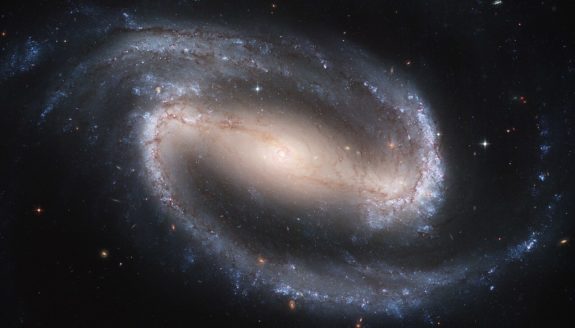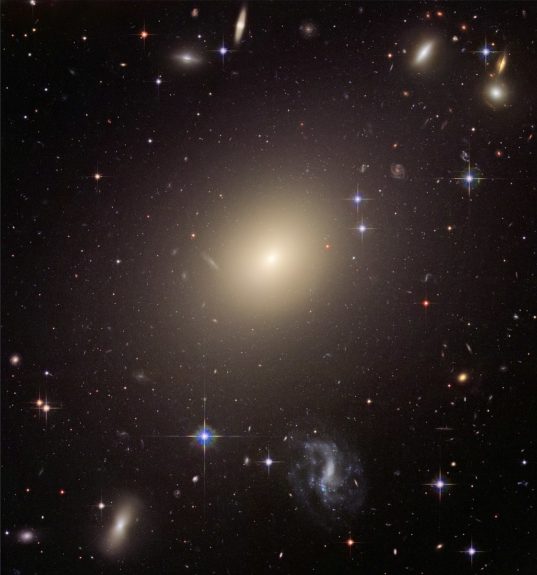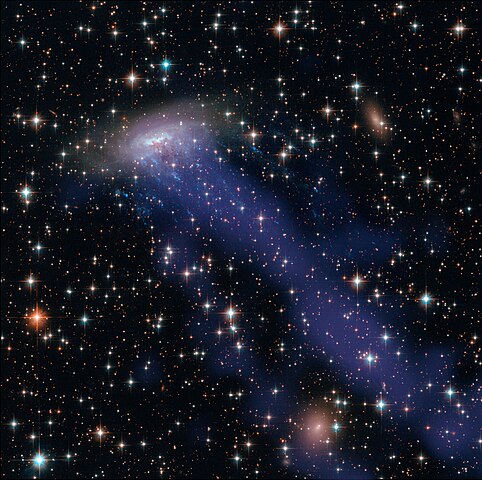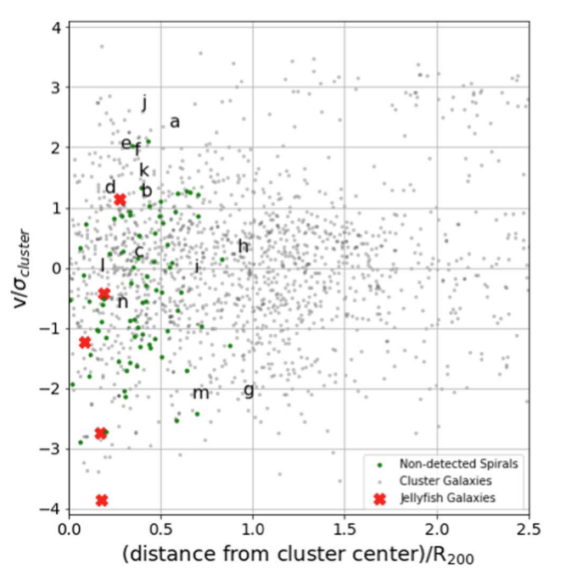On Friday, Staff Writer Elisha Dura attended Columbia Astronomy Public Outreach’s lecture, given by Dr. Nick Luber, on what we do and do not know about jellyfish galaxies. Read through the article to play an astronomy trivia game at the end!
Jellyfish in the sky? If you’re an astronomer, the answer is yes. At a Columbia Astronomy Public Outreach event on Friday, students, staff, families, and other avid astronomy enthusiasts gathered in Pupin Hall to hear Dr. Nick Luber share his knowledge on jellyfish galaxies and their habitats in the sky.
In typical Columbia Astronomy Outreach fashion, the night started off with astronomy trivia, led by Selina Yang (CC ’24). The questions can be found at the bottom of the article, but the real fun was found in Pupin Hall, where Yang’s stellar astronomy puns (get it?) left the audience laughing in their lecture seats.
After repping the organization’s new TikTok account—you could be their eleventh follower!—emcee Chris Carr introduced Dr. Nick Luber, a current Columbia Science Fellow on the Frontiers of Science team. Noting that audience members ranged from professors’ children to well-seasoned astronomers, Dr. Luber ensured he would keep the lecture lighthearted and engaging for the audience. In the hopes of keeping more people awake during this lecture than at his PhD dissertation, he asked his audience many questions throughout the talk and rewarded participants with mostly-space-themed candy. I’m telling you, Columbia Astronomy Public Outreach knows how to hold a lecture.
To begin to describe jellyfish galaxies, Dr. Luber offered a bit of Galaxy 101 knowledge about the two main types of galaxies. First, he described spiral galaxies, which are blue, disc-shaped, and have a significant amount of mass locked inside gas. The other type is known as an elliptical galaxy, which, as the name implies, has an elliptical shape that can range from being close to a sphere to an American football. These galaxies are red or yellow and, according to Dr. Luber, are not very beautiful in comparison to spiral galaxies.

A spiral galaxy 
An elliptical galaxy
However, Dr. Luber explained that there is also a third category known as peculiar galaxies, which includes jellyfish galaxies. While the jellyfish galaxy is a subset of spiral galaxies, it doesn’t quite follow all of the norms in terms of appearance. They form stars and are blue in color, yet they stand out by their tails that extend to lengths at least as long as the radius of the galaxy. These tails can be comprised of stars, ionized gas, neutral gas, or a combination of the three, giving rise to the name “jellyfish galaxy.”

Dr. Luber then moved into a description of the jellyfish galaxy’s “habitat”: galaxy clusters. They consist of hundreds to thousands of galaxies that can be moving at rates up to thousands of kilometers per second, and they contain a mixture of galaxy types. While large, bright elliptical galaxies mainly exist at their cores, spiral galaxies permeate the outskirts of galaxy clusters. Dr. Luber then asked, “Where are the jellyfish?”
To answer this question, Dr. Luber used a graph from his research. With the x-axis depicting the distance of a galaxy from the center of the cluster, we can see that the jellyfish galaxies live close to the center of clusters. However, the graph only includes a sample of five jellyfish galaxies, so when looking at the y-axis, which plots velocity, it isn’t apparent whether jellyfish galaxies move faster or slower than other galaxies. To clarify, Dr. Luber explained that a larger sample would reveal that jellyfish galaxies move quicker than other gas-rich galaxies through any given cluster.

After describing jellyfish galaxies’ features and habitat, Dr. Luber posed an important question: how does the jellyfish galaxy’s habitat affect their features? In his research, Dr. Luber seeks to answer this question using telescopes that observe radio waves, which can be used to find the amount of neutral gas—any gas that is stable and does not need to react to achieve the necessary electrons in its outer shell—in galaxies.
Typically, radio telescopes measure galaxies on the outskirts of clusters to have higher neutral gas content, while central galaxies are found to have little neutral gas content. This is due to a process called ram-pressure stripping, which describes when galaxies ram into things, much like the name suggests. (“Astronomers are not an imaginative bunch,” Dr. Luber joked.) More specifically, the process occurs when galaxies ram into the gas in the center of clusters, causing the gas to be pushed out of galaxies. Without gas, these galaxies cannot continue to form stars.
Considering that jellyfish galaxies live close to the center of galaxy clusters, Dr. Luber asked the audience a trick question: Do jellyfish galaxies have a lot of gas, a regular amount, or very little? Although he was generous with his candy to those who provided responses, Dr. Luber shot down all three potential answers with a grin. Instead, he told the audience that jellyfish galaxies hold an amount that falls “in between very little and regular.”
Given this information, Dr. Luber asked the audience if it was possible to devise a theory about the formation of jellyfish galaxies. “If we couldn’t, then this would probably be a very boring talk,” deadpanned one audience member. Synthesizing the lecture, Dr. Luber explained that jellyfish galaxies’ habitats influence their appearance. Their position in the center of clusters means that they experience a lot of ram-pressure stripping, yet it’s more difficult to push the gas out of jellyfish galaxies because of their abundance of stars. As a result, their gas can’t be pushed out quickly, which creates the beautiful long tails of removed gas—a jellyfish galaxy’s defining feature.
Although Dr. Luber provided us with a very easily digestible yet comprehensive lecture, he made sure to point out that we hadn’t answered all of the questions we could about jellyfish galaxies. Astronomers haven’t either, or else he warned that “several people in this audience would not have a PhD project!” Afterward, Dr. Luber concluded, “There’s still so much to learn about them.”
Perhaps these galaxies will be studied more because of Dr. Luber’s enthusiastic introductory lecture on them, open for all to hear. At least one young scientist in the crowd was eager to continue this work, and at the close of the Q&A session, she asked Dr. Luber why he chose to study jellyfish galaxies above all else. “I love the ocean, I love to sail, and I love to swim, so on a namesake, I think they’re so interesting,” he joked. His final answer to the question, however, captured the sheer curiosity that drives scientific discovery: “I think they’re one of the most beautiful objects in the sky that are not easily describable. Why do they look like that? And that’s really what drew me in.”
Header via Wikimedia Commons
Elliptical galaxy via Wikimedia Commons
Spiral galaxy via Wikimedia Commons
Jellyfish galaxy via Wikimedia Commons
Graph via The Astrophysical Journal
Trivia Qs
1. Most galaxies in the Universe are gravitationally clumped together into larger structures called galaxy groups and galaxy clusters. For instance, our Galaxy—The Milky Way—resides in the Local Group, which in turn resides in the Laniakea Supercluster. Approximately how many galaxies are in the Laniakea Supercluster
- 100
- 1,000
- 10,000
- 100,000
2. The space between galaxies in a galaxy cluster is filled with a hot gas called the intracluster medium, or ICM. In a typical cluster, roughly what fraction of the cluster’s total mass is in galaxies and what fraction is in the ICM?
- 15% galaxies, 85% ICM
- 85% galaxies, 15% ICM
- 50% galaxies, 50% ICM
- 5% galaxies, 15% ICM
3. As a galaxy evolves, its shape changes due to a variety of internal and external influences. One such channel of galaxy evolution is that of galactic mergers, through which multiple disc-shaped spiral galaxies can combine to form a puffy, round elliptical galaxy. In roughly how many years will our own spiral galaxy start merging with the nearby spiral galaxy Andromeda?
- 4.5 trillion years
- 1 trillion years
- 4.5 billion years
- 1 billion years
The answers are posted in the comments!


 1 Comments
1 Comments
1 Comment
@Julie Chow
1. D
2. D – The rest of the mass is found in dark matter, which is why these percentages do not add up to 100!
3. C